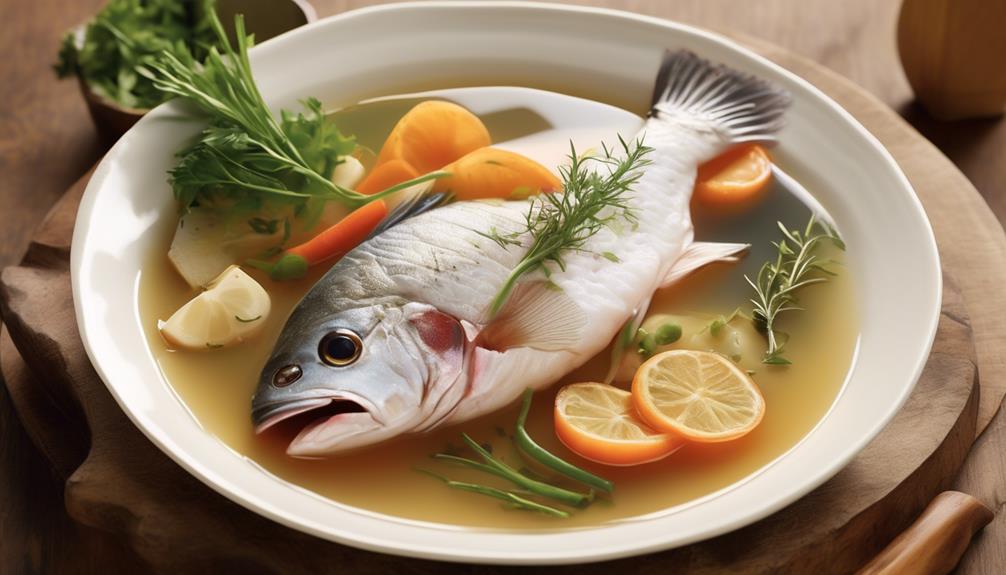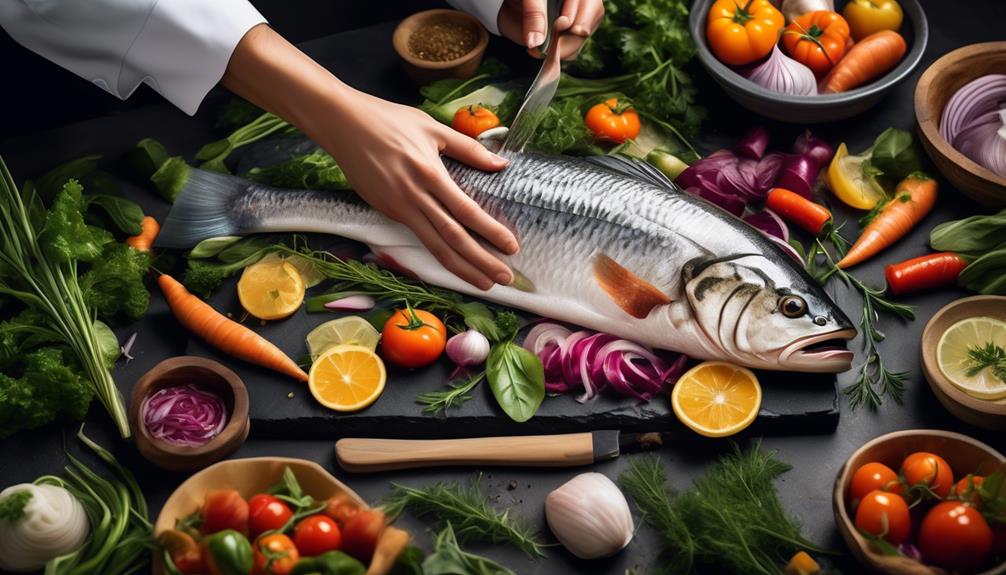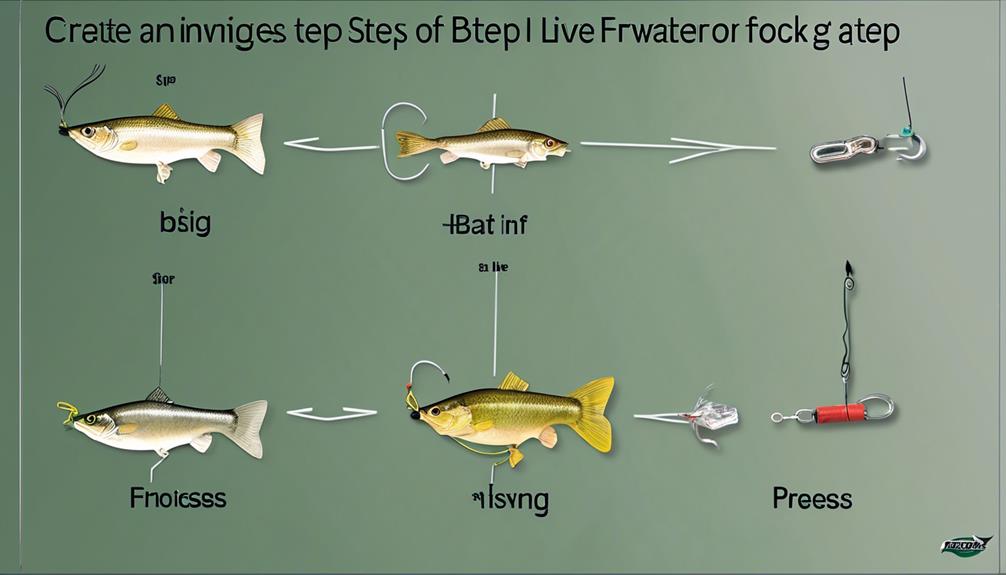Have you ever wondered why cooking freshwater fish seems like such an effortless task?
As you stand at the edge of a serene lake or river, you may find yourself contemplating the simplicity of transforming a freshly caught fish into a delectable meal. It's not just about the flavor; there's something inherently satisfying about the process itself.
There's a certain finesse to it, a timeless art that resonates with the very essence of nature. And as you consider the various methods of cooking freshwater fish, you'll discover that it's not just the end result that makes it so appealing, but the entire journey from water to table.
Selecting the Freshest Fish
When selecting the freshest fish, trust your senses to guide you in making the best choice for your culinary creation. Start by visiting a reputable fish market where you can find a wide variety of fish.
At the fish market, observe the appearance of the fish. Look for clear, bright eyes and red gills. The skin should be shiny and metallic, with scales that are intact. Fresh fish should also have a mild ocean scent, not a strong fishy odor. If the fish smells overly fishy, it mightn't be fresh. Additionally, pay attention to the texture of the fish. The flesh should be firm to the touch and should spring back when pressed.
Understanding fishing techniques can also help you select the freshest fish. Fish that have been caught using sustainable and responsible fishing methods are more likely to be fresh, as they're handled carefully from the moment they're caught to when they reach the market. Look for fish that have been caught using line and hook methods, as these techniques are known for their minimal impact on the environment and their ability to maintain the fish's quality.
Preparing the Fish for Cooking
After selecting the freshest fish, it's essential to properly prepare it for cooking to ensure the best flavor and texture in your dish. Cleaning the fish is the first step in preparing it for cooking. Start by rinsing the fish under cold water to remove any scales, slime, or debris. Use a knife or a fish scaler to scrape against the scales, working from the tail towards the head. Once the scales are removed, make an incision along the belly of the fish, from the vent to the head, and remove the innards. Be sure to discard the entrails properly.
Next, it's time to fillet the freshwater fish. Lay the fish on a clean cutting board and hold it firmly by the head. Insert a sharp knife behind the gills and make a long, clean cut along the backbone towards the tail. Then, carefully slide the knife along the backbone, separating the fillet from the bones. Repeat the process on the other side of the fish to obtain two fillets.
After filleting, it's crucial to remove any remaining bones from the fillets. Run your fingers along the flesh to feel for any pin bones. Use a clean pair of tweezers to pull out any bones you find. Once the fish is cleaned and filleted, it's ready to be cooked using your favorite freshwater fish recipes.
Properly preparing the fish ensures that you'll have a delicious and enjoyable meal.
Seasoning and Flavoring Options
To enhance the flavor of your freshwater fish, consider using a variety of seasonings and marinades to complement its natural taste.
Fish rubs and marinades are excellent options for adding depth and complexity to the flavor of your fish. A simple fish rub can be made using a combination of salt, pepper, garlic powder, and paprika. This can be applied generously to the fish before cooking to create a delicious outer crust.
Marinades, on the other hand, can be made using a mixture of olive oil, lemon juice, minced garlic, and herbs such as thyme and rosemary. Allowing the fish to sit in the marinade for at least 30 minutes before cooking will infuse it with incredible flavor.
Another fantastic way to season freshwater fish is by using herb butter. Create a compound butter by mixing softened butter with finely chopped herbs such as parsley, dill, and chives. Once mixed, roll the butter into a log using plastic wrap and refrigerate until firm. When ready to cook, simply slice a round of the herb butter and place it on top of the fish. As it melts, it will impart a rich and savory flavor to the fish.
Additionally, using citrus zest from lemons, limes, or oranges can add a refreshing and zesty twist to your freshwater fish. Simply sprinkle the zest over the fish before or after cooking to brighten its flavor.
These seasoning and flavoring options are sure to elevate your freshwater fish dishes to new heights.
Grilling Freshwater Fish
Wondering how to achieve the perfect grilled freshwater fish? Grilling freshwater fish can be a delicious and healthy way to enjoy your catch. To ensure a successful grilling experience, it's important to use the right grilling techniques and consider your marinade options.
When it comes to grilling techniques, a clean and well-oiled grill is crucial for preventing the fish from sticking. Preheat the grill to a medium-high heat and place the fish directly on the grates. If the fish has skin, start grilling with the skin side down to help hold the fish together. Avoid flipping the fish too often to prevent it from falling apart. Depending on the thickness of the fish, it usually takes about 4-6 minutes per side to cook through. To add a smoky flavor, consider using wood chips or planks on your grill.
Marinade options can greatly enhance the flavor of your grilled freshwater fish. A simple marinade of olive oil, lemon juice, garlic, and herbs can complement the natural taste of the fish. If you prefer a sweeter flavor, a marinade with honey, soy sauce, and ginger can add a delicious twist. Marinate the fish for at least 30 minutes before grilling to allow the flavors to penetrate the flesh.
Baking or Roasting Techniques
If you've mastered grilling freshwater fish, you can easily transition to baking or roasting techniques to further enhance the flavors of your catch. Baking or roasting freshwater fish is a versatile and convenient method that allows you to infuse your fish with a variety of flavors while maintaining its natural tenderness.
Here are some tips to help you perfect your baking or roasting techniques:
- Smoking fish: Experiment with different types of wood chips to impart distinct smoky flavors to your freshwater fish. Whether it's hickory for a robust taste or applewood for a sweeter aroma, smoking your fish can add a new dimension to its flavor profile.
- Temperature control: When roasting or baking freshwater fish, precise temperature control is crucial. Use a reliable meat thermometer to ensure your fish is cooked to perfection without becoming dry or overcooked.
- Seasoning and marinades: Elevate the flavors of your freshwater fish by using marinades or dry rubs before baking or roasting. Citrus-based marinades or a blend of herbs and spices can complement the natural taste of the fish.
- Sous vide techniques: Consider using sous vide methods before baking or roasting. This technique involves vacuum-sealing the fish and cooking it in a water bath at a precise temperature, resulting in tender and evenly cooked fish.
Pan-Frying Freshwater Fish
Consider pan-frying freshwater fish to achieve a crispy exterior and tender, flavorful flesh that will delight your taste buds. Pan-frying is a quick and easy cooking method that locks in the natural juices of the fish while creating a deliciously crunchy coating. To enhance the taste, start by marinating the fish in flavorful marinades such as lemon and herb, garlic and butter, or a tangy soy sauce blend. This step infuses the fish with added depth and richness.
Once marinated, coat the fish in a crispy coating, such as seasoned flour or breadcrumbs, to create a delightful texture contrast.
To pan-fry freshwater fish, begin by heating oil in a skillet over medium-high heat. The oil should be hot but not smoking. Gently place the coated fish into the skillet and cook until the coating turns golden brown and crispy, usually about 3-4 minutes per side, depending on the thickness of the fish. Ensure the fish is cooked through but still moist and flaky inside. The result is a perfectly cooked freshwater fish with a crispy, golden-brown exterior that gives way to moist, flavorful flesh.
Pan-frying freshwater fish is an excellent way to enjoy the natural flavors of the fish while adding a satisfying crunch. With the right marinade and crispy coating, you can elevate the taste of freshwater fish and create a dish that's sure to impress.
Poaching or Steaming Methods

To explore alternative cooking methods for freshwater fish, you can now learn about the poaching or steaming techniques, which offer a lighter and more delicate way to prepare the fish while preserving its natural flavors and moisture.
Poaching involves gently simmering the fish in flavorful liquid, such as broth or wine, while steaming uses the steam from boiling water to cook the fish. Both methods are excellent for retaining the fish's natural taste and tenderness. Here's why these techniques are worth trying:
- Flavor Infusion: Poaching or steaming allows the fish to absorb the flavors of the liquid it's cooked in, resulting in a subtle yet delicious taste that complements the natural flavor of the freshwater fish.
- Health Benefits: These cooking methods require minimal added fats, making them a healthier option for preparing freshwater fish. By using flavorful broths or aromatics, you can enhance the taste without relying on excessive oils or fats.
- Delicate Texture: Poaching and steaming help the fish retain its moisture and delicacy, ensuring a tender and succulent outcome that's hard to achieve with other cooking methods.
- Gentle Preparation: The gentle cooking process of poaching or steaming minimizes the risk of overcooking, preserving the fish's nutritional value and texture while making it an ideal choice for those who prefer milder flavors and softer textures.
Exploring these gentle cooking techniques can lead to a delightful culinary experience, showcasing the natural flavors and health benefits of freshwater fish.
Serving and Enjoying the Cooked Fish
To fully savor the flavors of your freshly cooked freshwater fish, consider serving it alongside a simple green salad or a side of steamed vegetables. The light and refreshing qualities of a green salad complement the delicate taste of the fish, while steamed vegetables add a nutritious and wholesome element to your meal.
When it comes to plating presentation, opt for a clean and minimalistic approach. Arrange the fish fillet neatly on the plate and add a pop of color with the vibrant greens of the salad or vegetables. Not only will this enhance the visual appeal of your dish, but it will also showcase the natural beauty of the fish.
As you sit down to enjoy your meal, remember to observe dining etiquette. Use the appropriate utensils and maintain good posture while dining. When tasting the fish, take small, deliberate bites to fully appreciate the flavors. Chew slowly and savor each mouthful. Engage in conversation and relish the company of those dining with you. Express your appreciation for the meal and the effort put into preparing it.
Frequently Asked Questions
Can Freshwater Fish Be Cooked Using the Same Methods as Saltwater Fish?
You can cook freshwater fish using the same methods as saltwater fish. Both types can be grilled, baked, or pan-fried. However, freshwater fish may have a milder flavor profile, so you might want to adjust seasonings accordingly.
Are There Any Specific Cooking Techniques That Work Best for Certain Types of Freshwater Fish?
When cooking freshwater fish, consider the best techniques for each type. Different species may benefit from specific methods: pan-frying works well for bass, while trout is delicious when grilled. Experiment with poaching recipes and baking tips for a variety of flavors.
What Are Some Common Mistakes to Avoid When Cooking Freshwater Fish?
When cooking freshwater fish, common mistakes to avoid include overcooking, not properly seasoning, and not adjusting cooking times based on the type of fish. Proper seasoning and paying attention to cooking times are crucial for delicious results.
Are There Any Health Considerations to Keep in Mind When Cooking Freshwater Fish?
When cooking freshwater fish, consider nutritional benefits and cooking precautions. Ensure proper handling, thorough cooking, and avoiding cross-contamination. Freshwater fish offer healthful omega-3s and lean protein, but be wary of potential contaminants.
How Can I Tell When Freshwater Fish Is Cooked Properly and Ready to Eat?
When cooking freshwater fish, check for flaky texture and opaque appearance. Use a food thermometer to ensure it reaches an internal temperature of 145°F. Cooking time varies based on the method and thickness of the fish.
Conclusion
So, now you know that cooking freshwater fish is an easy task. With the right selection, preparation, and cooking techniques, you can enjoy a delicious and healthy meal in no time.
Whether you prefer grilling, baking, pan-frying, or poaching, there are plenty of options to suit your taste.
So go ahead, give it a try and savor the flavors of fresh, cooked freshwater fish.



